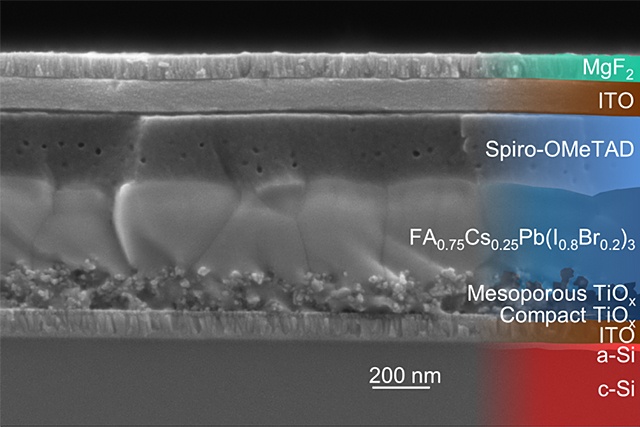MaNiTU – Materials for sustainable tandem solar cells with extremely high conversion efficiency
Solar cells with the highest efficiencies deliver electricity cost-effectively, demanding less space and materials. High efficiencies also enable new products, such as energy-independent buildings or electric cars, which can be recharged via solar cells. However, the efficiency of silicon solar cells can no longer be arbitrarily increased. The physical limits responsible for this can be overcome using tandem solar cells. With them, efficiencies above 35% are possible. Tandem solar cells are therefore in the focus of current solar cell research. At the same time, the photovoltaic capacity added annually will increase to more than 1 TWP worldwide within the next 5–10 years. These quantities also mean that critical materials (e.g. lead) are to be consistently avoided in the production of solar modules. Consequently, in the MaNiTu lighthouse project, six Fraunhofer institutes are joining forces in developing sustainable, highly efficient and cost-effective tandem solar cells based on new absorber materials.


“For Germany, the development of innovative and disruptive technologies such as tandem solar cells represents a further opportunity, alongside research, solar plant construction and the supply of materials, to carve out a leading role internationally in the manufacture of solar cells. This means that MaNiTU also opens up an alternative perspective for a successful European PV industry”, explains Dr. Andreas Bett, Head of the Fraunhofer Institute for Solar Energy Systems ISE and the project’s director.
Perovskite solar cell technology, which over the last ten years has managed to increase the efficiency of solar cells from 3.8 to 24.2%, has simplified the manufacture of cells and has the potential to substantially reduce production costs, lies at the heart of the project MaNiTU – materials for tandem solar cells with ultrahigh conversion efficiency. Perovskite materials are deemed to include any materials whose crystalline structure corresponds to that of the mineral calcium titanate. Such materials are especially good at absorbing light and enable high electron mobility – ideal for use in photovoltaic systems. Given their physical properties, these types of materials are also suited for use in tandem structures based on silicon solar cells.
However, the use of lead means that this material is not without its drawbacks. Given that over the next five to ten years the power output of photovoltaic installations will increase to over 1 TWp, the use of critical materials in the construction of solar modules must be avoided wherever possible. Starting out with familiar perovskite absorber materials, the MaNiTU employs ultramodern techniques from materials science to develop new lead-free absorber layers and contact and passivation layers suitable for use with the former, enabling critical and toxic materials to be excluded from the outset. The innovative approach consisting of handling absorber and contact layers together enables the targeted use of interface effects for the desired functionalities. Perovskite technology is then combined with conventional silicon technology. This is achieved by depositing perovskite cells directly on silicon solar cells. Given that the individual solar cells are particularly efficient at using different sections of the solar spectrum, efficiency overall is increased and more electricity can be generated using the same area of solar cells. At the end of the project stability and high rates of efficiency are demonstrated at module level.
This Fraunhofer landmark project is scheduled to last four years. The aim of this research program is to fully exploit the potential for synergies by pooling competencies at several Fraunhofer institutes to deliver solutions for the challenges faced by German industry. The goals of the MaNiTU project require the pooling of complementary competencies from different Fraunhofer institutes – ranging from theoretical and experimental materials sciences to technological, economic and ecological expertise on solar cells.
